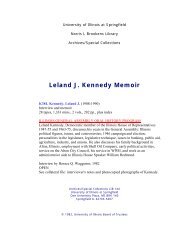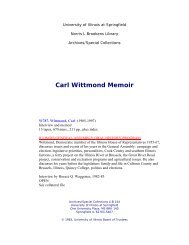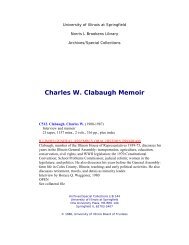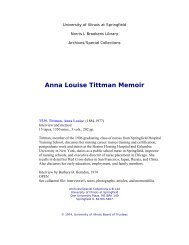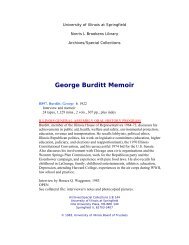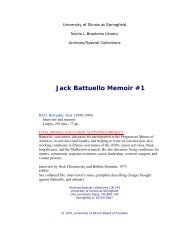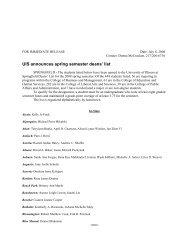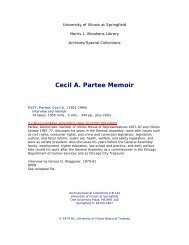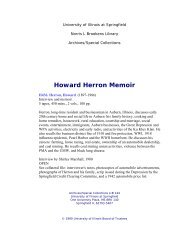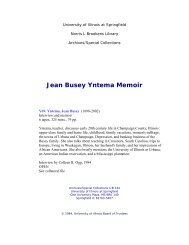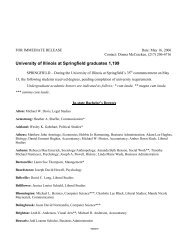Lillian Scalzo Memoir - University of Illinois Springfield
Lillian Scalzo Memoir - University of Illinois Springfield
Lillian Scalzo Memoir - University of Illinois Springfield
You also want an ePaper? Increase the reach of your titles
YUMPU automatically turns print PDFs into web optimized ePapers that Google loves.
<strong>University</strong> <strong>of</strong> <strong>Illinois</strong> at <strong>Springfield</strong><br />
Norris L Brookens Library<br />
Archives/Special Collections<br />
<strong>Lillian</strong> <strong>Scalzo</strong> <strong>Memoir</strong><br />
SCA49. <strong>Scalzo</strong>, <strong>Lillian</strong> (1900-1984)<br />
Interview and memoir<br />
1 tape, 60 mins., 28 pp.<br />
<strong>Scalzo</strong>, an artist, discusses her work and association with art, the <strong>Springfield</strong> Art<br />
Association, Vachel Lindsay and her art education.<br />
Interview by Melinda Kwedar, 1976<br />
OPEN<br />
See collateral file: interviewer's notes and photocopies <strong>of</strong> photographs and<br />
articles.<br />
Archives/Special Collections LIB 144<br />
<strong>University</strong> <strong>of</strong> <strong>Illinois</strong> at <strong>Springfield</strong><br />
One <strong>University</strong> Plaza, MS BRK 140<br />
<strong>Springfield</strong> IL 62703-5407<br />
© 1976, <strong>University</strong> <strong>of</strong> <strong>Illinois</strong> Board <strong>of</strong> Trustees
"A TRIBUTE TO LILLIAN SCALZO AND HER ART"<br />
<strong>Springfield</strong> Art Association Gallery<br />
April 22-29,1979<br />
Miss <strong>Lillian</strong> <strong>Scalzo</strong> undoubtedly inherited her artistic talent from her<br />
maternal grandfather, Joseph Maggenti <strong>of</strong> Florence, Italy. He came to America<br />
with a contractor whose specialty was the construction and decoration<br />
<strong>of</strong> ornate cathedrals and elaborate state capitols. In this capacity, he came<br />
to <strong>Springfield</strong> to make casts for plaster designs and bronze figures to be used<br />
in the Capitol, He bought the house at 325 W. Washington Street. Later,<br />
Miss <strong>Scalzo</strong>'s arents lived in this same house. It is the home in which she<br />
was born ~prif17,19OO and where she lives today.<br />
<strong>Lillian</strong> <strong>Scalzo</strong> received her first art training from George Robb at the<br />
<strong>Springfield</strong> Art Association. She studied illustration and costume design at<br />
the Chicago Academy <strong>of</strong> Fine Arts. She also studied at the Chicago Art<br />
Institute and the Chicago Academy <strong>of</strong> Design.<br />
When <strong>Springfield</strong> Junior College opened in 1929, she developed and directed<br />
their Art Department until World War 11, when art classes were discontinued.<br />
Whiie still teaching at the Junior College in 1936, she started<br />
teaching painting at the <strong>Springfield</strong> Art Association. After World War 11, the<br />
Art Association was able to hire a full-time director and Miss <strong>Scalzo</strong> resigned<br />
and became affiliated with the State Department <strong>of</strong> Health, illustrating medical<br />
pamphlets.<br />
She returned to teaching at the Art Association in the early 50's and<br />
continued until 1974. During over 40 yem <strong>of</strong> teaching, she has demonstrated<br />
her ability to inspire and guide thousands <strong>of</strong> persons to achieve their<br />
maximum ability. It is unusual to find a talented artist who can also communicate<br />
techniques so ably to students <strong>of</strong> varying degrees <strong>of</strong> capabilities.<br />
Her versatility as an artist is demonstrated by her pen and inks; linoleum<br />
block prints and etchings <strong>of</strong> the early 30's. She also did watercolor<br />
plates for costume designs used in several <strong>of</strong> the early Beaux Arts Balls,<br />
which were really extravagansas "almost like a ZeigBeld performance".<br />
This exhibition includes oils, watercolors, collages, and her most recent<br />
endeavor - stitchery. Miss <strong>Scalzo</strong> says "Stitchery is really painting pictures<br />
with thread and needle". Her use <strong>of</strong> thread includes a great variety <strong>of</strong> yarns<br />
<strong>of</strong> unusual textures as well as conventional embroidery stitches. She also<br />
uses various colorful fabrics and antique lace in her applique and stitchery<br />
pieces.<br />
It is a pleasure to show to Sprin@eld the work <strong>of</strong> a person who has devoted<br />
her life to her own expression and to helping others find ways to express<br />
themselves visually.
Table <strong>of</strong> Contents<br />
Birthplace. <strong>Springfield</strong>. <strong>Illinois</strong> ............... 1<br />
Family Background ....................... 2<br />
Education ........................... 4<br />
Music Lessons-Ursuline.. Study <strong>of</strong> Art at the<br />
<strong>Springfield</strong> Art Association and at the Art<br />
Institute in Chicago.. Development <strong>of</strong> Interest<br />
in Art.. Early Art Education<br />
First Job ........................... 6<br />
Mola ~aga's School ....................... 8<br />
<strong>Springfield</strong> Art Association .................. 9<br />
Copper Enameling ........................ 13<br />
Stitchery ........................... 14<br />
Vachel Lindsay ......................... 16<br />
Elizabeth [Mrs.<br />
Vachel] Lindsay ................ 18<br />
Lincoln Library Award ..................... 19<br />
Theory<strong>of</strong>Art ......................... 19<br />
- Ford Times1 Representative ................... 20<br />
View on Nudes in Art ...................... 22<br />
Art Collection ......................... 23<br />
Participation in Exhibits ................... 24<br />
Vachel Lindsay Association ................... 25
Preface<br />
This manuscript is the product <strong>of</strong> a tape recorded interview conducted by<br />
Melinda Kwedar in February <strong>of</strong> 1976. Rosalyn Bone rranscripted the tapes<br />
and Francis Staggs edited the transcript.<br />
<strong>Lillian</strong> <strong>Scalzo</strong> was born in <strong>Springfield</strong>, <strong>Illinois</strong> on April 17, 1900. Frpm<br />
first grade through high school she went to Ursuline Academy. She studied<br />
art on her om, and, after finishing high school, she studied art in<br />
<strong>Springfield</strong> and Chicago. She became a friend and admirer <strong>of</strong> Vachel<br />
Lindsay and was one <strong>of</strong> the founders <strong>of</strong> the Vachel Lindsay Assocation.<br />
<strong>Lillian</strong> <strong>Scalzo</strong> taught art at <strong>Springfield</strong> Junrio College and at the <strong>Springfield</strong><br />
Art Association. For a while, she designed costumes for the Beaux Arts<br />
Ball.<br />
Readers <strong>of</strong> the oral history memoir should bear in mind that it is a<br />
transcript <strong>of</strong> the spoken word, and that the interviewer, narrator and<br />
editor sought to preserve the informal, conversational style that is<br />
inherent in such historical sources. Sangamon State <strong>University</strong> is not<br />
responsible for the factual accuracy <strong>of</strong> the memoir, nor for views expressed<br />
therein; these are for the reader to judge.<br />
The manuscript may be read, quoted and cited freely. It may not be<br />
reproduced in whole or in part by any means, electronic or mechanical,<br />
without permission in writing from the Oral History Office, Sangamon<br />
State <strong>University</strong>, <strong>Springfield</strong>, <strong>Illinois</strong>, 62708.
<strong>Lillian</strong> <strong>Scalzo</strong>, February, 1976, <strong>Springfield</strong>, <strong>Illinois</strong>.<br />
Melinda Kwedar, Tntervlewer.<br />
Q: Miss <strong>Scalzo</strong>, I think we'll start at the beginning with your birthdate.<br />
What was the date <strong>of</strong> your birth?<br />
A: April 17, 1900.<br />
Q: Okay, and where were you born?<br />
A: Right in this very room.<br />
Q: In this room? Oh, my gosh.<br />
A: In this very . . . (laughs)<br />
Q: Well, I thought you were born in <strong>Springfield</strong>, but I certainly didn't<br />
realize that it's this exact location. So you were born at home?<br />
A: I was born at home, yes.<br />
Q: Was there a doctor in attendance?<br />
A: Oh yes, there was a doctor in attendance but we had no hospitals<br />
for--just St. John's at that time and they took no births.<br />
Q: Oh, they didn't?<br />
A: Oh, no, not in 1900. So . . . (laughs)<br />
Q: I didn't realize that. When did they . . .<br />
A: They didn't start with births until the <strong>Springfield</strong> Hospital started.<br />
Q: <strong>Springfield</strong> Hospital?<br />
A: Yes, which is now Memorial Hospital [Memorial Medical Center]. And<br />
they were the first ones that took births.<br />
Q: Do you remember about what time that would have been?<br />
A: That would have been about 1911.<br />
Q: I see. So, everybody was born at home.
<strong>Lillian</strong> <strong>Scalzo</strong> 2<br />
A: Everybody was born at home in those days. They always had nurses,<br />
that came to the house.<br />
Q: I see. And the doctor.<br />
A: And the doctor, <strong>of</strong> course, came and stayed all day (laughs) if you<br />
didn't, you know, if you didn't come right <strong>of</strong>f. (laughs)<br />
Q: Right. My gosh. Well, I didn't realize that. Now, could you tell<br />
me a little about your parents, what kind <strong>of</strong> work your father may have<br />
done or your mother.<br />
A: My father was in the fruit business and he ran the <strong>Springfield</strong> Produce<br />
and my mother, <strong>of</strong> course, did no work. (laughs) She was . . .<br />
Q: Outside <strong>of</strong> the . . .<br />
A: . . . she was just a housewife but she was a very fine musician.<br />
Q: Oh, she was.<br />
A: Yes.<br />
Q: What kind <strong>of</strong> music did she . . .<br />
A: Piano.<br />
Q: Did she have any formal training in piano?<br />
A: Oh, yes, yes. She had formal training in the piano. And she thought<br />
that I should be a musician. So my early life was all piano and violin<br />
instead <strong>of</strong> art.<br />
Q: I see, yes. Now did she ever do any public recitals or anything . .<br />
A; Oh, nothing like that except for in the city, you know.<br />
Q: In the city. Here?<br />
A: Oh, yes, yes, right here in town. You know how the clubs used to<br />
[give recitals] and the churches would give recitals and she would play<br />
for those.<br />
Q: So she did some public work around <strong>Springfield</strong>.<br />
A: Like that, yes.<br />
Q: Okay. Did you have any brothers or sisters?<br />
A: No, I didn't have any brothers or sisters except my cousin that--you<br />
see, my mother adopted her when she was four years old. Her mother died.<br />
No, as she was only six months old. And then her father married again<br />
and his second wife died and left another child four years old and my<br />
mother had her. So we were raised up as sisters. And we didn't know
<strong>Lillian</strong> <strong>Scalzo</strong> 3<br />
we weren't sisters until--we were kind <strong>of</strong> dumb in those days (laughs) and<br />
I had no idea my cousin Mary wasn't my sister until I went to school.<br />
And we both went to school together and one girl said she was wiser than<br />
us. She said, "Oh, she's not your sister." And I said, "She is my<br />
sister." "Well, she's got a different name than you."<br />
Q: Different last name.<br />
A: Yes, because it was my mother's brother. And with that I said,<br />
'Well, she is my sister," and I belted her one. So when I came home I<br />
was telling my mother and she says, "Well, you'll have to go back and<br />
apologize because Mary isn't your sister." (laughs)<br />
Q: Yes, and how much younger than . . .<br />
A: We were four years difference in age, you see.<br />
Q: 1 see. So you were four years when she came into the house.<br />
A: Yes. So I really had sisters.<br />
Q: Yes, and then the next one, how much younger was she, the next . . .<br />
A: I was eleven years old when she came in. That's how I knaw that it<br />
was about eleven years [after I was born] when the hospital took births<br />
because she was the first one born at the hospital.<br />
Q: Oh, I see. That would have been about 1911.<br />
A: Yes.<br />
Q: Okay. And this is the home that you . . .<br />
A: Well, this was my grandfather and grandmother's home. And my mother<br />
stayed here and lived with them. So . . .<br />
Q: I see, so you lived with grandparents as you were growing up as well.<br />
A: Yes.<br />
Q: When was the house built, do you know?<br />
A: Let's see, it's eighty-some years old. About eighty-two or three<br />
years old. So that'd be in the eighteen something or the other.<br />
Q: Eighteen nineties.<br />
A: I guess, about in there. Yes.<br />
Q: Right. Well, it really is quite old then, right?<br />
A: Yes. (laughs)
<strong>Lillian</strong> <strong>Scalzo</strong> 4<br />
Q: Did you ever feel that--when did you decide what you wanted to do<br />
with your life? Do you remember? As far as a career was concerned or<br />
what you'd like to do?<br />
A: Well, in those days you were told what to do with your life. (lavghs)<br />
You didn't decide. We were told where to go to school and I never thought<br />
anything about it. I just drifted into art and that's it. I like to do<br />
it.<br />
Q: But you did say that your mother was anxious for you to go into<br />
music.<br />
A: Oh, yes. Oh, yes, I had to study music, I had piano lessons twice a<br />
week, violin lessons twice a week, no art lessons at all. None, no.<br />
Q: Were they available at the time?<br />
A: No, they weren't. I went to the Ursuline Academy to school.<br />
Q: Okay, yes, that's what I was going to . . . Now, did you start school<br />
at Ursuline or is that . . .<br />
A: Yes, I started to school at Ursuline.<br />
Q: Like first grade.<br />
A: Yes.<br />
Q: So you went there through high school age?<br />
A: Yes, graduated from there.<br />
Q: Okay. Then after high school what did you d .o in way<br />
A: Well, I had to wait until my cousin was graduated from high school.<br />
So the two <strong>of</strong> us then went to Chicago and she decided to study music and<br />
go on with music and then I went to the Art Institute to study art. I<br />
got my first chance then to study art. But while I was waiting in-between<br />
I went out to the <strong>Springfield</strong> Art Association. They had then commenced<br />
to have classes. And they had an art director there who gave a few<br />
lessons in drawing and painting and I went during those--well, for about<br />
two years and then from then on, I went to the Art [Institute] in Chicago.<br />
Q: Right. Now you graduated from high school in 19182<br />
A: Yes.<br />
Q: Okay, so it was around that time that the art association started to<br />
have the classes?<br />
A: Yes,<br />
Q: And so you stayed for two years and then went to Chicago in around<br />
1920, 19211
<strong>Lillian</strong> <strong>Scalzo</strong><br />
A: Twenty-one.<br />
Q: Nineteen twenty-one. And then how many years did you study at the<br />
Art Institute?<br />
A: About two years there.<br />
Q: And did they have a formal kind <strong>of</strong> curriculum or did you go like<br />
eight hours a day or what was the arrangement?<br />
A: This is a very formal school. You went everyday from nine in the<br />
morning till four in the afternoon. And in the morning you did nothing<br />
but draw from the model and in the afternoon was a11 different kinds <strong>of</strong><br />
techniques; like pen and ink and watercolor. The first years you mostly<br />
did drawings and your second year you went into watercolor and oil. But<br />
every year your morning classes were always drawing from the model.<br />
Q: From a live person?<br />
A: Live. Oh, yes.<br />
Q: Now, was the two-year period the accepted course <strong>of</strong> study where . . .<br />
A: Oh, yes, this is the accepted course.<br />
Q: So after two years you in effect graduated from that.<br />
A: Well, I didn't really graduate but we didn't go back because my<br />
cousin had graduated in her music as far as she wanted to go and she<br />
commenced teaching. And then we would go to summer school every summer.<br />
Q: In Chicago?<br />
A: In Chicago.<br />
Q: I see. So when your cousin finished you and she came back to <strong>Springfield</strong>?<br />
A: Yes.<br />
Q: Okay. When did you start painting or when did you decide you had an<br />
interest in art?<br />
A: I guess not until I went to school. I didn't like music. It was to<br />
=--it was real hard work and I wasn't good at it so I asked if I could<br />
go to the Institute instead <strong>of</strong> studying music. So they let me. And<br />
that's the only thing [that I decided], but never decided really, that I<br />
was going to be an artist.<br />
Q: One <strong>of</strong> the articles that 1 read said that you sold a painting at the<br />
age <strong>of</strong> sixteen. Do you remember that? That that one was the first one<br />
that you sold?
<strong>Lillian</strong> <strong>Scalzo</strong> 6<br />
A: Well, yes, I remember that. But it wasn't really (laughs) nothing to<br />
rave about. I think I painted the flag and somebody draped over a c<strong>of</strong>fin<br />
and somebody (laughs) was collecting flags. So the man bought the picture.<br />
Q: I see. So you were working with things . . .<br />
A: Oh, yes. Oh, yes.<br />
Q: . . , a11 the time.<br />
A: Yes, yes.<br />
Q: Just on your own pretty much. Did they give any kind <strong>of</strong> art classes<br />
at Ursuline? I mean was this . . .<br />
A: No, we didn't have any art at all at Ursuline, no.<br />
Q: Okay, so you came back to <strong>Springfield</strong> in about 1923 and what did you<br />
do then?<br />
A: I just worked for myself. I just drew pictures and oh, what most <strong>of</strong><br />
the Victorian girls were doing at that time. Going to the shows and<br />
movies. (laughs)<br />
Q: So you didn't have a job?<br />
A: No, I had no work. No.<br />
Q: And you lived at home with your parents?<br />
A: Yes.<br />
Q: And your cousin did as well?<br />
A: Yes.<br />
Q: So, then when did you . . . what was your first job outside the home?<br />
A: I commenced teaching for <strong>Springfield</strong> Junior College when they opened<br />
up the college, and the first year I took the art department and I taught<br />
out there. That was my first job.<br />
Q: Why did you decide to go to work at that point?<br />
A: Well, I really wanted something to do and that was the only thing I<br />
could find to do in <strong>Springfield</strong> because there was no opening in the<br />
commercial art because I didn't letter or do anything like that. So the<br />
only field that I could get into was to teach. And I didn't want to<br />
teach in the public schools because when you graduated from the Art<br />
Institute you didn't have a degree to teach in the public schools.<br />
Q: Right. And they weren't giving art in the schools at that time,<br />
anyway, right?
<strong>Lillian</strong> <strong>Scalzo</strong> 7<br />
A: No.<br />
Q: Okay. Around what year was that, do you remember when?<br />
A: About in--I imagine about 1929.<br />
Q: Nineteen twenty-nine.<br />
Q: Yes.<br />
Q: Okay. And that's when Spri .ngfield College opened up.<br />
A: Yes.<br />
Q: Okay. And how long did you teach there?<br />
A: I really couldn't tell you. I told you I was terrible on dates.<br />
(laughs)<br />
Q: Okay, well, I have five years here so I assume that's close enough.<br />
A: That'll be close enough.<br />
Q: Okay. Can you tell me something about your job there, how you liked<br />
it and what you were doing and so forth?<br />
A: Well, my job was to teach on Saturday because it wasn't really connected<br />
with the college. And they didn't have enough degrees to have an art<br />
department, enough books or anything like that that would decide that<br />
they could give a degree in art, don't you see.<br />
Q: Oh, I see. So this was just an extra.<br />
A: And this was just extra. So anyone who wanted to take art would take<br />
it on a Saturday or I taught two nights a week for adults. We had adult<br />
classes also.<br />
Q: Through <strong>Springfield</strong> College.<br />
A: Yes, And what I was teaching was actually commercial art. Because I<br />
had studied during the summers I had studied commercial art. I didn't go<br />
back to the Art Institute, I went to different places in Chicago. And<br />
then I went to the Mola Naga School which was real Ear out, and studied<br />
there, design.<br />
Q: Now, where was that?<br />
A: That was mostly design. And you use those things in commercial art,<br />
don't you see. So I was teaching classes more like that than just painting<br />
classes.<br />
Q: Now this school that you were just talking about that you said was<br />
far out, was that far out <strong>of</strong> Chicago or , . .
<strong>Lillian</strong> <strong>Scalzo</strong> 8<br />
A: No, it was Mola Naga [who] came from Germany from the Bauhaus.<br />
You've heard <strong>of</strong> the Bauhaus?<br />
A: Yes.<br />
A: And he opened this--it was during the Nazi time--and he opened this<br />
school. He had to leave Germany. The Bauhaus was closed and he was one<br />
<strong>of</strong> the great teachers there. And he came to Chicago and someone gave him<br />
enough money to open this school and it was a very different school in<br />
any kind <strong>of</strong> teaching we had here in the United States. For instance,<br />
instead <strong>of</strong> having our model sit for--well, when you go to the Institute<br />
the model would stay in the same position for the whole week and you drew<br />
that on that painting, on that drawing all week long. But when you went<br />
to his school you had to draw the moving figure. You only had six minutes<br />
to do a moving figure. The figure would, for instance, if the figure was<br />
standing it would commence to turn. The model would turn and you had to<br />
catch each turn that it made as well as you could as quickly as you<br />
could. And maybe at the end <strong>of</strong> a session you would have to have about--well,<br />
up to about thirty or forty drawings.<br />
Q: My gosh. So that each time a perspective would change, you would<br />
redraw the whole thing.<br />
A: Yes, maybe--well, as much as you could catch. Maybe you could just<br />
catch the movement, maybe you just got part <strong>of</strong> the figure moving. The<br />
figure would start standing and then moving to a chair and then seat<br />
itself and move up out <strong>of</strong> the chair and then walk again with its back to<br />
you and then turn and come and lie down on the floor and (laughs) it was<br />
very exciting.<br />
Q: Yes, I can imagine. Now what was the point <strong>of</strong> that, to train you to<br />
...<br />
A: Because Mola Naga's whole idea was that nothing now actually stands<br />
still, Everything is moving. Your cars move by quickly, you don't<br />
really stand and look at things but you move by things real quickly.<br />
It's actually what he called vision in motion.<br />
Q: Now, where was this school located?<br />
A: In an old house on Michigan Avenue.<br />
0<br />
Q: In Chicago.<br />
A: In Chicago, An old kind <strong>of</strong> a barn-like house. It didn't last long.<br />
Q: How long were you . . . .<br />
A: I just had two summers there.<br />
Q: Oh, two summers. So he was there for two years.<br />
A: Oh, he was there longer than that but I was only there two summers.<br />
First, we had two summers and then the school closed for want <strong>of</strong> funds,
<strong>Lillian</strong> <strong>Scalzo</strong> 9<br />
then it opened up again but I never went back any more. Because then; I<br />
commenced teaching. !<br />
Q: Did you feel that your training there was valuable?<br />
A: Most valuable training that I had.<br />
Q: Really?<br />
A: Oh, yes. Definitely.<br />
Q: Now your classes with <strong>Springfield</strong> Junior College you say were geared<br />
toward commercial art.<br />
A: Yes, more like illustration, pen and ink, and watercolor that you<br />
would use in illustration. And dress design, everything like that.<br />
Q: Was that your choice to . . .<br />
A: No, that's what they wanted.<br />
Q: I see. So they told you, in effect, what to teach, right? Or what<br />
kind <strong>of</strong> thing they wanted. Okay. All right, so you taught with <strong>Springfield</strong><br />
Junior College for about five years and then did you go right to the<br />
[<strong>Springfield</strong>] Art Association next?<br />
A: Well, that was just kind <strong>of</strong>, oh, you might say an accident. I knew<br />
the president, Mr. Trutter. And the <strong>Springfield</strong> Art Association was kind<br />
<strong>of</strong> on the verge <strong>of</strong> closing up. Because it had no art classes and the<br />
house was given to the [<strong>Springfield</strong>] Art Association with the stipulation<br />
that it must always have an art class and if it didn't have or didn't<br />
have a teacher to teach art classes, then they would lose the house.<br />
Q: Now, this was the Edwards place?<br />
A: The Edwards place, yes.<br />
Q: The same house that they're using now.<br />
A: Yes. It would revert back to the heirs. So Mr. Trutter was president<br />
at the time and he was a great friend <strong>of</strong> mine and our family's and he<br />
says, "We're just about to close up, <strong>Lillian</strong>." He says, "Do you think<br />
you could just kind <strong>of</strong> start a class there?" He said, "And maybe we<br />
could hold on.'' He says, "We can't pay you any salary or anything like<br />
that." So I just started a class <strong>of</strong> a few or five or six women and I<br />
said, "We'll just go out and paint together and we'll put up still lifes,"<br />
because I wanted to paint, too, and I wasn't, you know, really getting<br />
any painting in what between teaching and oh, doing housework and things<br />
like that. (laughs) And so I was delighted with the idea so we started<br />
with about six women and we brought our own still lifes but we weren't<br />
really a class, yet. So after the first six months other people asked if<br />
they could come in and join us--other women-and we said, "Yes." So then<br />
Mr. Trutter says, t'Well, let's make it a class, ~illian," he said. "And<br />
that way," he said, "let them pay you."
<strong>Lillian</strong> <strong>Scalzo</strong> 10<br />
Q: The people that wanted . . .<br />
A: The people . So, instead <strong>of</strong> me being able to paint<br />
with them I just gradually drifted into being their teacher. So, that's<br />
how the classes started at the art association.<br />
Q: And at that time you were still teaching at <strong>Springfield</strong> Junior College.<br />
A: Yes, I was there, yes. I was still there.<br />
Q: So then from that first class, how did it expand to <strong>of</strong>fering such a<br />
wide variety?<br />
A: You mean at the art association?<br />
Q: Right.<br />
A: Well, the first classes were nothing but people, women, who came who<br />
had had painting in college and wanted to go back to it and had families.<br />
They were a11 older women as you can see by this picture. And they had<br />
painted before so most <strong>of</strong> them were doing watercolors or oils. And<br />
that's what we did. And then the classes just naturally grew like topsy<br />
and then after a time I was teaching three days a week instead <strong>of</strong> two<br />
afternoons. So it became . . .<br />
Q: Three full days.<br />
A: Yes. So it became so heavy I gave up the junior college classes then<br />
and I couldn't keep up both because I never had any time then to work for<br />
myself.<br />
Q: Right. So this was in the early l93Ots, you think around that time.<br />
A: Yes. Around that time. Yes.<br />
Q: Okay. So then can you tell me about some <strong>of</strong> the other classes that<br />
you were involved in other than the painting?<br />
A: Well, we weren't involved in the other classes until the Second World<br />
War came on and people couldn't travel any more. They didn't have the<br />
gasoline, and they wanted something to do so they started adult classes.<br />
And the <strong>Springfield</strong> Art Association--then I had been really almost directing<br />
all <strong>of</strong> the classes--they wanted me to direct these classes. So I got<br />
different teachers to come out and we <strong>of</strong>fered etchings and lithography<br />
and pottery. And because people had nothing to do, don't you see, they<br />
flocked to classes, And the tuition was very, very low. I think they<br />
only paid about five dollars.<br />
Q: For a semester?<br />
A: For a whole sememster. Well, see, it was <strong>of</strong>fered like by the city.<br />
The city was actually paying all <strong>of</strong> the teachers' salaries.
<strong>Lillian</strong> <strong>Scalzo</strong> 11<br />
Q: Oh they were! Wasn't that a private . . .<br />
A: No, it was not a private thing at all. But we gave the [<strong>Springfield</strong>]<br />
Art Association classrooms for them. And we had, actually, the first<br />
pottery classes that were in <strong>Springfield</strong>. We didn't have a kiln, though.<br />
I had a very good teacher from one <strong>of</strong> the public schools who had had<br />
potter with<br />
from Cranbrook but she couldn't teach pottery in<br />
the schools because they didn't have it here. But she was delighted to<br />
come out there, so we got the clay and we decided we'd find someplace in<br />
Chicago to Eire the things. And we had to drive to Chicago with the<br />
pottery and bring it back and forth. Then we found out that the <strong>Springfield</strong><br />
brickyard would fire them for us.<br />
Q: Oh, well that was a little more convenient.<br />
A: It was much better than going back and forth to Chicago. And after a<br />
time we got a very small kiln, and it ws so successful that we talked<br />
the school board into introducing pottery into the school.<br />
Q: Oh, well good. That was great. So most <strong>of</strong> your teachers that you<br />
recruited from town, were they teachers in the public schools?<br />
A: No, they weren't. Now, the one woman who taught etching was Mss<br />
Virginia Brown and she was caretaker at the Lincoln Home. But [she] had<br />
done small etchings for herself and had an etching press, which we needed.<br />
So she was delighted to teach out there. And then the one who taught<br />
lithography, Mr. Bum, said he would buy us a lithograph press and stones<br />
if we would get someone to teach lithography. So a young man that I had<br />
taught at <strong>Springfield</strong> Junior College had been to Chicago and had had a<br />
little bit <strong>of</strong> lithography. So I got him to teach.<br />
Q: So you recruited these people. They were more or less personal<br />
acquaintances.<br />
A: They were personal acquaintances and I always attended the classes<br />
because that way I learned also. (laughs)<br />
Q: Right. So you were a participant in these classes?<br />
A: Oh, yes, yes.<br />
Q: Okay. I think one <strong>of</strong> the articles talked about a class in art appreciation.<br />
Did you teach that at one time?<br />
A: Oh yes. No, I didn't teach it but I always gave it because I found<br />
out that if you talked to people and let them see art that they would<br />
change their opinions about art. See, I was trying to bring them up-to-date.<br />
But you can't bring people up-to-date unless they know something or see<br />
something. So I just gave those on my own.<br />
Q: Oh, 1 see. Did you talk about the history <strong>of</strong> art at all or was it<br />
just a matter <strong>of</strong> . . .
<strong>Lillian</strong> <strong>Scalzo</strong> 12<br />
A: No, I didn't talk about the history <strong>of</strong> art. What I wanted them to<br />
know was all about [Pablo] Picasso and [Henri] Matisse and all the people<br />
that they hated and that I liked. So I would gather--I was a book collector<br />
and a picture collector, a pro<strong>of</strong> collector--so I would bring a11 <strong>of</strong> my<br />
things and talk as much as I possibly could to make them understand, if I<br />
could, what these artists were trying to do. So most <strong>of</strong> it was from the<br />
Impressionists up to the contemporary people.<br />
Q: I see, Did you feel that you made any headway there?<br />
A: Yes, I felt that I made a great deal because lots <strong>of</strong> times--I still<br />
feel I did--because lots <strong>of</strong> times I meet people and they say, "Miss<br />
<strong>Scalzo</strong>, we didn't understand you at the time, but we see now just exactly<br />
what you were talking about."<br />
Q: Well, that's great.<br />
A: But it was a little discouraging at the time. (laughs)<br />
Q: Yes, I can imagine. Did you also teach a class <strong>of</strong> ballet?<br />
A: No.<br />
Q: About ballet?<br />
A: Oh no, but I had studied ballet and I imagine that's what really<br />
turned me to art because I enjoyed the costumes more than the dancing.<br />
And I have always painted dancers and then when we commenced with the<br />
ball, I designed their costumes.<br />
Q: For the Beaux Arts Ball?<br />
A: Yes, because they always had a kind <strong>of</strong> sketch instead <strong>of</strong> what it is<br />
now. See now it's more like a de beaux project but the early balls were<br />
always done with a certain theme and that theme would require so many <strong>of</strong><br />
the girls to be dressed like the Great Waltz. They had thirty couples<br />
doing the Great Waltz. Then we had the Jewel Ball and we had a Lithuanian<br />
Ball. The very first ball was a costume ball and Vachel Lindsay was one<br />
<strong>of</strong> the judges for that ball.<br />
Q: You remember what year that was?<br />
A: No, I really don't.<br />
Q: Probably in the 1930ts?<br />
A: No, I don't think so. I think that it would be earlier, it seems<br />
like to me. Because I was still in art school.<br />
Q: Oh.<br />
A: Yes. I wasn't teaching then. But I remember the ball.
<strong>Lillian</strong> <strong>Scalzo</strong><br />
Q: So it was late 19201s, right?<br />
A: It must have been. Yes.<br />
Q: But you made the costumes for them or you designed the costumes?<br />
A: I would design the costumes and about ten <strong>of</strong> the women would order<br />
their material from theatrical companies and make the costumes. They<br />
were perfectly beautiful.<br />
Q: My gosh, what a project. (laughter) I thought it was a lot <strong>of</strong> work<br />
now.<br />
A: Oh no, their project was terrific, especially when they made the<br />
thirty costumes for the Great Waltz. See, what you had to do was consider<br />
expense, So you made a basic pattern and then you would change that so<br />
that each girl was different.<br />
Q: Oh, my gosh. So they weren't just identical dresses, all thirty <strong>of</strong><br />
these,<br />
A: Oh no, they weren't identical. Oh no, they were all different dresses.<br />
Q: What about architecture? Did you teach a class about that one time?<br />
A: No, I didn't. No, I never did anything in architecture.<br />
Q: One <strong>of</strong> the articles mentioned a silver wire bowl as a kind <strong>of</strong> . . .<br />
A: Well, that would be in enameling, I imagine. Now we commenced to do<br />
an enameling class and naturally as I said, I always joined the classes<br />
so that's how I took up enameling.<br />
Q: Now, is this copper enameling?<br />
A: Yes, that's copper enameling.<br />
Q: And how was this done? Simply? (laughter)<br />
A: The enamels are powders and they hardly show what color they are<br />
going to be until they have been baked in a real high heat in an enamel<br />
oven. And you shake them on like little aalt shakers. And it has to be<br />
stuck in the kiln right away. Maybe it's in only a minute or two minutes<br />
and they melt and they form like a glass, and that's what makes the<br />
beauty <strong>of</strong> the enamel.<br />
Q: And this is done on?<br />
A: On copper.<br />
Q: On copper.<br />
A: Yes.
<strong>Lillian</strong> <strong>Scalzo</strong> 14<br />
Q: That's interesting. I wonder, do they still do that out there, do<br />
you know?<br />
A: No, they don't do it any more. Not since I quit teaching. I taught<br />
it out there,<br />
Q: Then you did after your first initiation . . .<br />
A: Oh yes, after my first [class] I became the teacher.<br />
Q: What about ceramics, did you do work there or teach it?<br />
A: Yes, I never taught ceramics but 1've done a lot <strong>of</strong> ceramics.<br />
Q: Now this article also mentioned stitchery collage?<br />
A: Well, yes, I got into stitchery just a few years ago and have had<br />
done quite a bit <strong>of</strong> stitchery since then,<br />
Q: What kind are you talking about?<br />
A: One <strong>of</strong> the pictures was in the book. She was holding one.<br />
Q: Can you tell me how this is done?<br />
A: Just like you were embroidering with a needle and all different color<br />
thread.<br />
Q: And your materials that you use are . . .<br />
A: Materials are up to you. Whatever you want to use.<br />
Q: Any kind <strong>of</strong> a fabric, then, right?<br />
A: Any sort <strong>of</strong> fabric. You could get the stitcheries that are in the<br />
drawer there.<br />
Q: You do have some at home?<br />
A: Oh, yes.<br />
Q: Now, is this work that you've done on your own, right, since the<br />
[<strong>Springfield</strong>] Art Association?<br />
A: Oh, I've done this always on my own. I've done all my work on my<br />
own.<br />
Q: Yes, but I mean this was not a class that you taught?<br />
A: No, I never taught stitchery. I just do it for myself. It's a<br />
little tedious and a very long drawn out thing. It takes months maybe<br />
for you to do one. So people now--enameling is different. Enameling is<br />
done right at the moment. Maybe you can turn out ten or twelve pair <strong>of</strong><br />
earrings in a morning. Because it has to be done quickly. But stitchery's
<strong>Lillian</strong> <strong>Scalzo</strong> 15<br />
done very slowly and it's a very tedious job.<br />
not very many people want to do it.<br />
And so you really don't,<br />
Q: Is this like crewelwork and those kinds <strong>of</strong> things?<br />
A: Yes, those kinds <strong>of</strong> things.<br />
Q: They are lovely products when they're finished. This is one that<br />
you're working on?<br />
A: This isn't finished.<br />
Q: Well, that's lovely.<br />
A: See what they are?<br />
Q: Yes, I can see that. How did you learn to do those stitches?<br />
A: Well, you have to make up your mind how--you learn these stitches<br />
from books, <strong>of</strong> course, and practice them up and then you go ahead.<br />
Q: You decided which to use where yourself.<br />
A: Yes, that's right.<br />
. . .<br />
Q: Well, that's very, very pretty. And you've been working on that just<br />
A: Well, when I broke my legs.<br />
Q: Last year.<br />
A: Yes. See, that's the way it goes.<br />
Q: Yes, that is very, very nice.<br />
A: But you use whatever materials you wish. Now a great many people--<br />
hardly anybody uses lace, but I'm very fond <strong>of</strong> lace and collected a lot<br />
<strong>of</strong> it. So I use a lot <strong>of</strong> lace.<br />
Q: How did you collect lace?<br />
A: Well, I don't know. When you go to Salvation Army stores and places<br />
like that. See, this was an old lace collar,<br />
Q: Yes, I can see that there.<br />
A: I had about . . .<br />
Q: Oh, that was the actual collar.<br />
A: That was the actual collar. I had about ten lace collars that I did<br />
but I don't think that I have any <strong>of</strong> them, I think they're all sold.
<strong>Lillian</strong> <strong>Scalzo</strong> 16<br />
Q: Now you are still selling some <strong>of</strong> these products?<br />
A: Oh, yes.<br />
Q: Is this just through word <strong>of</strong> mouth?<br />
A: That's all.<br />
Q: And somebody who wants to come and look at it?<br />
A: Oh, yes, yes.<br />
Q: You told me that you knew Vachel Lindsay. Can you tell me about<br />
that?<br />
A: Well, I knew him after he'd returned to <strong>Springfield</strong> to make his home.<br />
I meant him and went to the house. And he used to--after we'd have<br />
dinner in the dining room--we'd sit around the table, he and Roman Proctor,<br />
who was the puppeteer, and his wife, Mrs. Proctor, and Vachel would give<br />
each <strong>of</strong> us a different colored pencil. He would have a pencil, a different<br />
color and he would start. You see, Vachel's--many <strong>of</strong> his poems are done<br />
after he has done his drawings.<br />
Q: Oh, I see. So it started with the art work.<br />
A: Be always found himself an artist and not a poet. He signed himself<br />
Vachel Lindsay, artist.<br />
Q: Well, I wasn' t aware <strong>of</strong> that.<br />
A: And he would start a scribble, what you would call a scribble and he<br />
would pass it to each one <strong>of</strong> us to make a picture out <strong>of</strong> it. And if you<br />
couldn't see any picture in it, then you would pass it on to the next<br />
person and [on to] whoever saw the picture. And then [that person] would<br />
pass [it] back to him and he would write the poem under it, right then<br />
and there. And maybe you'd do about twenty <strong>of</strong> those <strong>of</strong> an evening.<br />
Q: Twenty.<br />
A: Well, he could scribble real fast.<br />
Q: And he could write the poems as quickly as that?<br />
A: Oh, it was terrific. It was just terrific what he could do. And<br />
once in a while he would give us one.<br />
Q: Give you a poem?<br />
A: Well, give us the finished thing, the poem and the drawing but most<br />
all <strong>of</strong> them he kept really himself.<br />
Q: Do you have any <strong>of</strong> them?
<strong>Lillian</strong> <strong>Scalzo</strong> 17<br />
A: I had two <strong>of</strong> them but I gave them to the house. They're down in the<br />
house framed. And Roman Proctor gave his, too, to the [<strong>Springfield</strong> Art]<br />
Association.<br />
Q: Now on those were the finished product <strong>of</strong> the art work, did he go<br />
ahead if--like if you made a picture <strong>of</strong> it then was your picture on the<br />
finished product?<br />
A: Yes, it was on the finished product. Yes. Yes, you would just<br />
acutally, maybe you saw a bird in it, an owl or something like that.<br />
Well, you would just finish it on but you would keep the same flow <strong>of</strong><br />
lines he did. See, that's the reason he wouldn't ask a great many people<br />
because a lot <strong>of</strong> people couldn't . . .<br />
Q: I was going to say, I would think you'd have to be very artistic . .<br />
A: You had to really be the same type <strong>of</strong> artist. See, that was the type<br />
<strong>of</strong> artist that the Bauhaus showed. [The type <strong>of</strong> drawing] was that you<br />
did continuous lines, you didn't raise your hand <strong>of</strong>f the paper. And you<br />
never drew with your fingers, you always draw with your whole body and<br />
your whole arm.<br />
Q: So how many years did you bow Vachel Lindsay?<br />
A: Up until the time he died.<br />
Q: And you knew his family as well?<br />
A: Yes.<br />
Q: Did his wife come on these little social affairs?<br />
A: Oh, she was always--it was down at his house. It was inside the<br />
house.<br />
Q: Oh, I see. So he invited you into these.<br />
A: Yes. It was always done at his house.<br />
Q: Now, this one picture you have [is] <strong>of</strong> him giving a recitation for<br />
the [<strong>Springfield</strong>] Art Association.<br />
A: Yes.<br />
Q: Did he do that quite <strong>of</strong>ten?<br />
A: Not quite <strong>of</strong>ten. But when he returned to <strong>Springfield</strong> to live they<br />
invited him to have a one-man show <strong>of</strong> his own paintings. And it was the<br />
first one-man ahow that he ever had. So the three rooms that are parlors<br />
now was our gallery at that time. And he came and hung his paintings<br />
there and then he gave a recital <strong>of</strong> his poems. And that's when he recited<br />
the Chinese Nightingale.
<strong>Lillian</strong> <strong>Scalzo</strong> 18<br />
Q: This was one time that this happened or did it happen . . .<br />
A: Yes. No, it just happened that once.<br />
Q: Was this fairly well-attended?<br />
A: It was very, very well-attended. People were sitting on the steps<br />
and outside. It was beautifully attended.<br />
Q: That's great. I had heard that he was not too popular here in town,<br />
or at least people thought he was nuts or whatever.<br />
A: Well, most people felt that he was odd. (laughter) And different.<br />
Q: I suppose he probably was.<br />
A: Naturally, but he had a great many friends and there were quite a few<br />
<strong>of</strong> us that appreciated it. So naturally they all appeared and they were<br />
delighted. But I remember when I was at school at the Ursuline Academy,<br />
he came out many times to recite his poems for the school.<br />
Q: Oh really?<br />
A: Yes. And you know, he has many poem like the Potato Dance and those<br />
things that you join in and the students would all join in. They just<br />
loved to have him.<br />
Q: Yes, I didn't realize that he went to--did he go to public schools,<br />
too?<br />
A: Yes, he'd go wherever he was invited, He was a very social person<br />
and loved to have people recite with him. Vachel had the idea that<br />
poetry was not to be read--which it isn't--it's supposed to be read abud<br />
or recited aloud so that many people can enjoy it.<br />
Q: In other words, it wasn't to be read silently, right?<br />
A: No. It's like a song or something that you can even dance to. You<br />
know, many <strong>of</strong> his poems you can dance to.<br />
Q: Yes, I know about the drums, the beating <strong>of</strong> the drums. Did you know<br />
about his private life? His relationship to his wife? Now, he did not<br />
have an actual occupation at this time, right? This was his life.<br />
A: Yes, he was just here. He didn't have any occupation at that time.<br />
He wasn't teaching or lecturing. He was just writing the whole time he<br />
was here.<br />
Q: And his wife did not work outside <strong>of</strong> the home either?<br />
A: No. She was writing, though, also.<br />
Q: Oh, I see.
<strong>Lillian</strong> <strong>Scalzo</strong> 19<br />
A: And I think that she was a poet in her own right. And I think that<br />
someone out in California has collected her poems and is publishing them.<br />
Q: Oh, really?<br />
A: Yes.<br />
Q: Now what was her first name?<br />
A: Elizabeth.<br />
End <strong>of</strong> Side One, Tape One<br />
Q: <strong>Lillian</strong>, you received an award given by the Lincoln Library. Can you<br />
tell me about that?<br />
A: Well, the Lincoln Library each year was picking out someone who had<br />
done something for <strong>Springfield</strong> and they thought that T had done more for<br />
the art in <strong>Springfield</strong> to make it more popular than anyone else, so<br />
that's the reason they picked me. It wasn't for my painting but for all<br />
the work I'd done for the [<strong>Springfield</strong>] Art Association and promoting art<br />
in <strong>Springfield</strong>. Because we had not only had adult painting classes, but<br />
we also had children's classes. Maybe as many as a hundred children on<br />
Saturdays. And I had brought real good exhibits for the [<strong>Springfield</strong>]<br />
Art Association, so that's the reason they had picked me out more than<br />
for my painting itself. I'm pretty sure that was it. (laughs)<br />
Q: This was in April <strong>of</strong> 1960, I see. And so [then] they had a dinner.<br />
A: Yes, they would always have a dinner where anyone in the city could<br />
come and they always had an outside speaker.<br />
Q: That must have been very nice.<br />
A: Well, it was really nice, yes.<br />
Q: Let's see now. I have a quotation here that you said, "The way to be<br />
a painter is to paint.'' And I was just wondering what part that you<br />
thought instruction has in this.<br />
A: I don't think that instruction had any part at all.<br />
Q: Really?<br />
A: I think what you have to do is to inspire the person to be himself<br />
and let himself go and do his thing, in other words. The only part that<br />
instruction comes into is the use <strong>of</strong> your material, how to use your brush<br />
and your paint and your canvas, or your watercolor paper, but the whole<br />
thing is actually to inspire the person to forget himself and be himself.<br />
Q: So in your teaching, I assume, you just felt that you were teaching<br />
how to use materials, is that right?
<strong>Lillian</strong> <strong>Scalzo</strong> 20<br />
A: That's all I did, really.<br />
Q: What about things like perspective and that kind <strong>of</strong> art. Are there<br />
techniques for teaching someone how to interpret, how to put this on<br />
paper, you know, how to get this perspective?<br />
A: There are techniques, but perspective and the mechanics <strong>of</strong> art really<br />
count very, very little.<br />
Q: But you can teach this, right?<br />
A: Yes, you can teach it. But I think when you teach it you kill the<br />
personality <strong>of</strong> the person. The person tightens up and becomes so conscious<br />
<strong>of</strong> doing perspective or something in that order that the person is not<br />
himself any more and he is not interpreting what he sees. What you<br />
actually teach is to teach the person how to see. Before a person studies,<br />
many <strong>of</strong> them that come into your class never have looked at anything.<br />
They don't know what a leaf actually looks like until you bring in a leaf<br />
and show them how beautiful it is, the line it has and that every leaf is<br />
different from the other leaf, no matter if it comes from the same tree<br />
or not. That even a blade <strong>of</strong> grass, the way it curves is just beautiful.<br />
And one blade <strong>of</strong> grass or one line on a paper is beautiful. It doesn't<br />
have to have perspective. Perspective is a necessity if you're doing<br />
commercial art and requires something <strong>of</strong> that type. But when you're<br />
teaching a class who is going to be nothing but painters you don't have<br />
to do anything like that. What you have to do is to teach them how to<br />
see, to use their eyes.<br />
Q: I see. But if the student wanted to learn, you know, if they, in<br />
essence, had a still life or something and they needed or felt like they<br />
wanted a perspective in there you could say, "Well, you can do it this,<br />
that, or the other way."<br />
A: Well, you teach them how to see that one object is behind the other<br />
object, but you don't just actually teach them perspective any more.<br />
Because if the thing is out <strong>of</strong> perspective, like a great many <strong>of</strong> [Jean<br />
Charles] ~azin's paintings, the table is tipped. They are not in perspective,<br />
but they are magnificent paintings.<br />
q: Right. Okay. All right, now, you had some <strong>of</strong> your paintings about<br />
New Salem that was in a publication called Ford Times? --<br />
A: Yes.<br />
Q: Can you tell me how this came about? Were you contacted for this?<br />
--<br />
A: Oh, yes. Those were the first ones that I had done for Ford Times.<br />
--<br />
Ford Times really looks up an artist in a certain district and they<br />
contact the artist to maybe do an eating place that is famous for a<br />
certain recipe. Have you ever noticed the recipes in the eating places<br />
in the back?<br />
Q: Right.
<strong>Lillian</strong> <strong>Scalzo</strong> 2 1<br />
A: Well, they had contacted me to do an eating place here in <strong>Springfield</strong><br />
called--I can't think <strong>of</strong> it now--so that's how I became their representative<br />
here in this area.<br />
Q: How did they how about you?<br />
A: They had seen one <strong>of</strong> my watercolors in a watercolor show. The director<br />
had. And he then contacted me and asked me if I would do this one painting.<br />
And I did that and then from then on I did many paintings besides the New<br />
Salem one. I did one <strong>of</strong> a group <strong>of</strong> paintings for Masters--oh, what's the<br />
name <strong>of</strong> his now? Edgar Lee Masters.<br />
Q: Oh, Edgar Lee Masters, right.<br />
A: I did his . . .<br />
Q: His home?<br />
A: No, not his home.<br />
Q: His book, you mean?<br />
A: Yes, his book.<br />
Q: I see. Spoon River Anthology?<br />
A: Yes, I did a number <strong>of</strong> paintings for that. And then a great many<br />
eating places and different old houses and things through <strong>Illinois</strong>.<br />
Q: Now, were you paid for this?<br />
A: Oh, yea. They give you a contract and they pay you so much a picture<br />
and so much time to do it in. You have limited time to do it so they'll<br />
be ready for publication.<br />
Q: Why did they do New Salem?<br />
A: Well, New Salem--they do many things to attract people for travel.<br />
Ford Times is a travel book. --<br />
Q: Ford automobile.<br />
A: Yes, so New Salem was the new and great attraction for travelers so<br />
that's the reason they did New Salem.<br />
Q: And how long did it take you to do those?<br />
A: I had a month to do them in.<br />
Q: A month. And how many did you do?<br />
A: I think there are eight or nine in there. I don't remember. You can<br />
do as many as you wish. It's up to you.
<strong>Lillian</strong> <strong>Scalzo</strong><br />
Q: This was in 1959, I see, right?<br />
A: Yes. (counts paintings) I did seven.<br />
Q: Oh, I missed the two on the back. Now, how did you do these?<br />
A: Oh, I went out and sketched them and then I took photographs. And<br />
then I came back and painted them, because they have to be done twice the<br />
size or maybe four times the size. They're bigger than this table when<br />
they're done. They're quite large.<br />
And what kind 05 paint did you use?<br />
I used casein with a pallet knife.<br />
And what is casein?<br />
Casein is a heavy watercolor.<br />
So the affect is somewhat like . . .<br />
Oil.<br />
Like oil.<br />
Yes.<br />
Did you ever teach a class on household gadgets? Using household<br />
gadgets?<br />
A: No. No.<br />
Q: T saw that in one <strong>of</strong> those articles and I thought well.<br />
A: No.<br />
Q: That didn't sound too much like your line. One time you were quoted<br />
as saying--talking about painting nudes and you said that you had to "be<br />
in a nudi mood." (laughter)<br />
A: No, when I was doing enamelings I did a great many nudes in enamel<br />
which are very difficult to do.<br />
Q: Oh, I can imagine.<br />
A: Yes, and that's the reason I said, "You have to be in a nudi mood."<br />
And I love nudes. I think they're the most beautiful thing you can do.<br />
Q: Yes. What is a "nudi mood?"<br />
A: Well, you just feel at that time that you want to do a nude instead<br />
<strong>of</strong> doing sorething else. You're inspired by nudes.
<strong>Lillian</strong> <strong>Scalzo</strong> 23<br />
Q: With a lot <strong>of</strong> your training at the [<strong>Springfield</strong>] Art Association and<br />
so forth you said live models were used. Were they . . .<br />
A: Not at the [<strong>Springfield</strong>] Art Association, we never had any models at<br />
all. We had nothing but still lifes.<br />
Q: At the Art Institute in Chicago?<br />
A: Oh, at the Art Institute, yes. Well, most all the schools have a<br />
great many--they always have a class in nudes. They do now out at Sangamon<br />
State, ~ ' m sure.<br />
Q: Yes. I think they do at the [<strong>Springfield</strong>] Art Association now, too,<br />
from what I understand.<br />
A: Yes, yes.<br />
Q: Did you ever have a problem <strong>of</strong> conflict between a choice <strong>of</strong> marriage<br />
or a career?<br />
A: No.<br />
Q: Did you ever feel that you've been discriminated against because you<br />
were a woman?<br />
A: No,<br />
Q: Treated differently or didn't get what you should have gotten or<br />
anything like that?<br />
A: No, I guess because I was too busy and I enjoyed what I was doing so<br />
much I never thought <strong>of</strong> it.<br />
Q: Did you think that you had any special problems that a man might not<br />
have had?<br />
A: No.<br />
Q: All right. Now your home here you told me is eight years old and I<br />
was told that you have a collection here, an art collection?<br />
A: Yes, I have a beautiful collection <strong>of</strong> prints and I have a wonderful<br />
collection <strong>of</strong> books,<br />
Q: Now, are your prints up and around or [do] you have them in a special<br />
room?<br />
A: No, I don't put them around. I just take one out at a time and look<br />
at it. I don't believe in having so much around. That's a print there.<br />
Q: Oh, I see.<br />
A: That's a silk screen <strong>of</strong> Sister Mary
<strong>Lillian</strong> <strong>Scalzo</strong> 24<br />
Q: ~hat'a beautiful. So you just periodically change what you put like<br />
in this place.<br />
A: Yes. I have about ten Candides. And I have Caillavets and<br />
and I have about . . .<br />
Q: These are originals, right?<br />
A: Theee are all originals. About twenty-five old Japanese prints.<br />
Q: Oh, great. So how many . . .<br />
A: I have no idea how many I have. I'm one <strong>of</strong> those collectors that<br />
just collect. (laughter) I'm an awful person. I collect everything.<br />
(laughs) Just everything. Even junk. Even string and rope. I love<br />
rope.<br />
Q: String and rope, you collect?<br />
A: Oh, yea. (laughs) Oh, it comes in handy. 1t's beautiful on pictures.<br />
1t's beautiful in stitchery.<br />
Q: Yes, I can imagine it would be. You have a in tapestry?<br />
A: No, I don't.<br />
Q: I see here you have a scrapbook and there are many articles, newspaper<br />
articles, that have been written about you from about 1938 or 1939. I<br />
see that there is a picture <strong>of</strong> what's said to be one <strong>of</strong> your first art<br />
classes, And 1946, here is a painting that, watercolor called "Swan<br />
Lake." You received a prize for this?<br />
A: Yes.<br />
Q: Now who gave the prize?<br />
A: Well, it was the--it was in Decatur, the show was, and we had what we<br />
called the Central Art Association with this kind <strong>of</strong> like . . .<br />
Q: Oh, provincial kind or district.<br />
A: District kind <strong>of</strong> <strong>Illinois</strong> artists.<br />
Q: Let's see. Did you participate in a lot <strong>of</strong> exhibits and shows an<br />
forth?<br />
A: Not too many. It was too much work,<br />
Q: Oh, really? (laughter)<br />
A: Well, it is. Getting them ready and sending them <strong>of</strong>f and back.<br />
Q: Yes, I can think it would be. Here you are honored by a reception<br />
here at the [<strong>Springfield</strong>] Art Association and here's about Vachel Lindsay.
<strong>Lillian</strong> <strong>Scalzo</strong> 25<br />
Let's see, you have a unique art course here. Well, thia talks about the<br />
course in architecture focusing on Frank Lloyd Wright. Was this a course<br />
that was given? Do you remember?<br />
A: Yes.<br />
Q: Oh, you have been a member <strong>of</strong> the Vachel Lindsay Association, right?<br />
A: Oh, yes.<br />
Q: And how long have you been involved in that?<br />
A: Ever since its beginning. I was one <strong>of</strong> the founders <strong>of</strong> it.<br />
Q: You were an <strong>of</strong>ficer?<br />
A: Yes.<br />
Q: Which <strong>of</strong>fice did you hold?<br />
A: Well, I was vice-president for I don't know how many years. (laughs)<br />
Q: And your main duty there was to . , . to what? Just keep up the<br />
house?<br />
A: Well, that's most <strong>of</strong> our duty is to keep up the house and help out<br />
Elizabeth [Graham] when she needs help to go through the house.<br />
Q: Did you do some tours yourself?<br />
A: Oh, yes, yes. And then whenever she had a program. I gave two<br />
programs for them, one on Vachel Lindsay as an artist and then I gave<br />
another program on--I always stuck to his art part. But that was about<br />
all you do with the Vachel Lindsay Society.<br />
Oh, sometimes you take<br />
certain visitors through when Elizabeth can't, but she's there most <strong>of</strong><br />
the time.<br />
Q: Right. Now here is a publication in 1970 talking about . . .<br />
A: Well, that's the International Enamel Show in which I had a piece <strong>of</strong><br />
enamel.<br />
Q: Okay. And this was in 1970.<br />
A: Yes. That was quite an honor because that was International.<br />
Q: Right. I can see that it is. It's very nice.<br />
End <strong>of</strong> Tape



